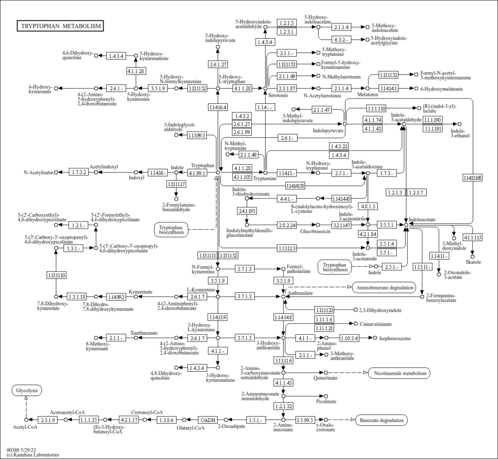| Experimental LC-MS/MS | LC-MS/MS Spectrum - N-Methyltryptamine LC-ESI-QQ , positive-QTOF | splash10-004i-0900000000-9f3d3580f44ff890d948 | 2017-09-14 | HMDB team, MONA | View Spectrum |
| Experimental LC-MS/MS | LC-MS/MS Spectrum - N-Methyltryptamine LC-ESI-QQ , positive-QTOF | splash10-0006-0900000000-822848a623cb94520599 | 2017-09-14 | HMDB team, MONA | View Spectrum |
| Experimental LC-MS/MS | LC-MS/MS Spectrum - N-Methyltryptamine LC-ESI-QQ , positive-QTOF | splash10-0006-0900000000-aeca37a42c6e04d4325c | 2017-09-14 | HMDB team, MONA | View Spectrum |
| Experimental LC-MS/MS | LC-MS/MS Spectrum - N-Methyltryptamine LC-ESI-QQ , positive-QTOF | splash10-00kf-1900000000-d53eab471c68809fb7c8 | 2017-09-14 | HMDB team, MONA | View Spectrum |
| Experimental LC-MS/MS | LC-MS/MS Spectrum - N-Methyltryptamine LC-ESI-QQ , positive-QTOF | splash10-00kf-5900000000-f4083668545bda855210 | 2017-09-14 | HMDB team, MONA | View Spectrum |
| Experimental LC-MS/MS | LC-MS/MS Spectrum - N-Methyltryptamine 20V, Positive-QTOF | splash10-0006-0900000000-355e913a45ee33e9295c | 2021-09-20 | HMDB team, MONA | View Spectrum |
| Experimental LC-MS/MS | LC-MS/MS Spectrum - N-Methyltryptamine 40V, Positive-QTOF | splash10-00kf-5900000000-1b4d8e3ddf4ea31ba73e | 2021-09-20 | HMDB team, MONA | View Spectrum |
| Experimental LC-MS/MS | LC-MS/MS Spectrum - N-Methyltryptamine 40V, Positive-QTOF | splash10-00kf-5900000000-fbbe54b40b8af9d897c6 | 2021-09-20 | HMDB team, MONA | View Spectrum |
| Experimental LC-MS/MS | LC-MS/MS Spectrum - N-Methyltryptamine 10V, Positive-QTOF | splash10-0006-0900000000-0e2a8616131b493185b5 | 2021-09-20 | HMDB team, MONA | View Spectrum |
| Experimental LC-MS/MS | LC-MS/MS Spectrum - N-Methyltryptamine 10V, Negative-QTOF | splash10-00di-0900000000-1c80db89940328726fb2 | 2021-09-20 | HMDB team, MONA | View Spectrum |
| Experimental LC-MS/MS | LC-MS/MS Spectrum - N-Methyltryptamine 20V, Positive-QTOF | splash10-0006-0900000000-4d1da80c5173955a7550 | 2021-09-20 | HMDB team, MONA | View Spectrum |
| Experimental LC-MS/MS | LC-MS/MS Spectrum - N-Methyltryptamine 10V, Positive-QTOF | splash10-0006-0900000000-5de268ec5bd72e565bca | 2021-09-20 | HMDB team, MONA | View Spectrum |
| Experimental LC-MS/MS | LC-MS/MS Spectrum - N-Methyltryptamine 40V, Negative-QTOF | splash10-014r-5900000000-8c15e85abc899ccef959 | 2021-09-20 | HMDB team, MONA | View Spectrum |
| Experimental LC-MS/MS | LC-MS/MS Spectrum - N-Methyltryptamine 40V, Negative-QTOF | splash10-0006-9000000000-1eed92d8ef02bbec784e | 2021-09-20 | HMDB team, MONA | View Spectrum |
| Experimental LC-MS/MS | LC-MS/MS Spectrum - N-Methyltryptamine 20V, Negative-QTOF | splash10-00b9-0900000000-429679de84f745409dc6 | 2021-09-20 | HMDB team, MONA | View Spectrum |
| Experimental LC-MS/MS | LC-MS/MS Spectrum - N-Methyltryptamine 20V, Negative-QTOF | splash10-00b9-0900000000-1f7051f1660d63ba423f | 2021-09-20 | HMDB team, MONA | View Spectrum |
| Experimental LC-MS/MS | LC-MS/MS Spectrum - N-Methyltryptamine 10V, Negative-QTOF | splash10-00di-0900000000-715b206cdf07055bc030 | 2021-09-20 | HMDB team, MONA | View Spectrum |
| Predicted LC-MS/MS | Predicted LC-MS/MS Spectrum - N-Methyltryptamine 10V, Positive-QTOF | splash10-004l-0900000000-4d5e4238b68a10b624f6 | 2016-08-03 | Wishart Lab | View Spectrum |
| Predicted LC-MS/MS | Predicted LC-MS/MS Spectrum - N-Methyltryptamine 20V, Positive-QTOF | splash10-0006-1900000000-eee318bc268c45febfc3 | 2016-08-03 | Wishart Lab | View Spectrum |
| Predicted LC-MS/MS | Predicted LC-MS/MS Spectrum - N-Methyltryptamine 40V, Positive-QTOF | splash10-015c-2900000000-1a64ba33dbf7376a39fe | 2016-08-03 | Wishart Lab | View Spectrum |
| Predicted LC-MS/MS | Predicted LC-MS/MS Spectrum - N-Methyltryptamine 10V, Negative-QTOF | splash10-00di-0900000000-4c2bf25ab0e52c7eea97 | 2016-08-03 | Wishart Lab | View Spectrum |
| Predicted LC-MS/MS | Predicted LC-MS/MS Spectrum - N-Methyltryptamine 20V, Negative-QTOF | splash10-00di-0900000000-ccc8d0f0f96ce2885b89 | 2016-08-03 | Wishart Lab | View Spectrum |
| Predicted LC-MS/MS | Predicted LC-MS/MS Spectrum - N-Methyltryptamine 40V, Negative-QTOF | splash10-015c-2900000000-03489d7c3b16f79c3868 | 2016-08-03 | Wishart Lab | View Spectrum |
| Predicted LC-MS/MS | Predicted LC-MS/MS Spectrum - N-Methyltryptamine 10V, Positive-QTOF | splash10-0006-0900000000-e5d0ebf20455b6c0a953 | 2021-09-23 | Wishart Lab | View Spectrum |
| Predicted LC-MS/MS | Predicted LC-MS/MS Spectrum - N-Methyltryptamine 20V, Positive-QTOF | splash10-0006-1900000000-cfcdbac3cdba755294fb | 2021-09-23 | Wishart Lab | View Spectrum |
